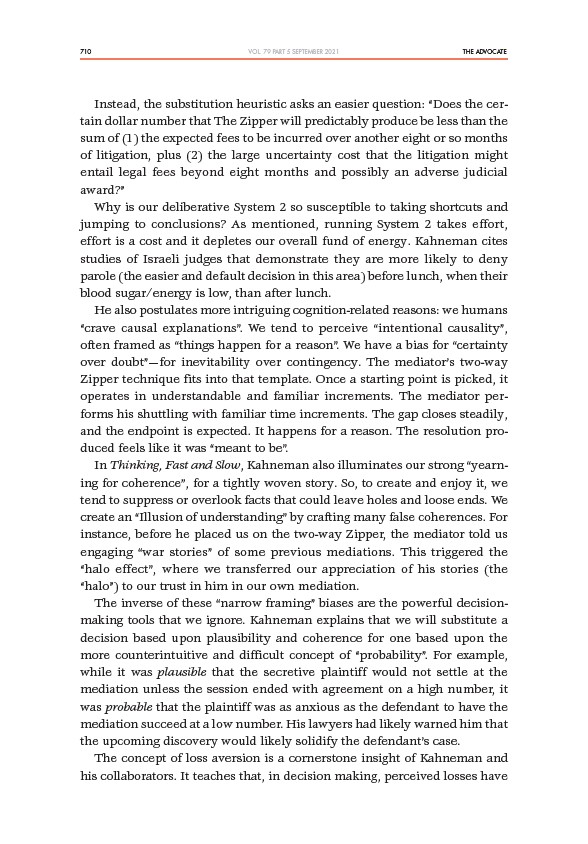
710 THE ADVOCATE
VOL. 79 PART 5 SEPTEMBER 2021
Instead, the substitution heuristic asks an easier question: “Does the certain
dollar number that The Zipper will predictably produce be less than the
sum of (1) the expected fees to be incurred over another eight or so months
of litigation, plus (2) the large uncertainty cost that the litigation might
entail legal fees beyond eight months and possibly an adverse judicial
award?”
Why is our deliberative System 2 so susceptible to taking shortcuts and
jumping to conclusions? As mentioned, running System 2 takes effort,
effort is a cost and it depletes our overall fund of energy. Kahneman cites
studies of Israeli judges that demonstrate they are more likely to deny
parole (the easier and default decision in this area) before lunch, when their
blood sugar/energy is low, than after lunch.
He also postulates more intriguing cognition-related reasons: we humans
“crave causal explanations”. We tend to perceive “intentional causality”,
often framed as “things happen for a reason”. We have a bias for “certainty
over doubt”—for inevitability over contingency. The mediator’s two-way
Zipper technique fits into that template. Once a starting point is picked, it
operates in understandable and familiar increments. The mediator performs
his shuttling with familiar time increments. The gap closes steadily,
and the endpoint is expected. It happens for a reason. The resolution produced
feels like it was “meant to be”.
In Thinking, Fast and Slow, Kahneman also illuminates our strong “yearning
for coherence”, for a tightly woven story. So, to create and enjoy it, we
tend to suppress or overlook facts that could leave holes and loose ends. We
create an “Illusion of understanding” by crafting many false coherences. For
instance, before he placed us on the two-way Zipper, the mediator told us
engaging “war stories” of some previous mediations. This triggered the
“halo effect”, where we transferred our appreciation of his stories (the
“halo”) to our trust in him in our own mediation.
The inverse of these “narrow framing” biases are the powerful decisionmaking
tools that we ignore. Kahneman explains that we will substitute a
decision based upon plausibility and coherence for one based upon the
more counterintuitive and difficult concept of “probability”. For example,
while it was plausible that the secretive plaintiff would not settle at the
mediation unless the session ended with agreement on a high number, it
was probable that the plaintiff was as anxious as the defendant to have the
mediation succeed at a low number. His lawyers had likely warned him that
the upcoming discovery would likely solidify the defendant’s case.
The concept of loss aversion is a cornerstone insight of Kahneman and
his collaborators. It teaches that, in decision making, perceived losses have